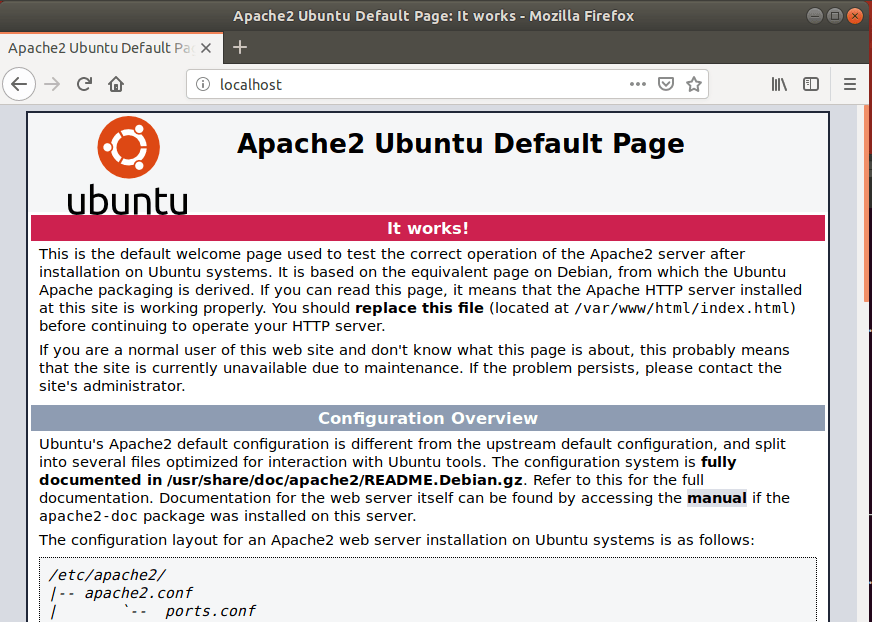It provides full website analytics for small and medium size businesses and webmasters who want to know how their web pages are performing and how to improve them. When you want to take full control of your website analytics and data without using third-party solutions, like Google Analytics, then OWA is a great place to start. OWA also comes with built-in support for tracking websites made with popular content management frameworks such as WordPress and MediaWiki and comes with other features that may not be available with other analytics platforms. For more on OWA, please visit its home page
Install Apache2 HTTP Server
Apache2 HTTP Server is the most popular web server in use. so install it, since OWA needs it. To install Apache2 HTTP on the Ubuntu server, run the commands below. After installing Apache2, the commands below can be used to stop, start and enable the Apache2 service to always start up with the server boots. To test whether Apache2 is installed, open your browser and browse to the server hostname or IP address. When you see that, then Apache2 is working as expected.
Install MariaDB Database Server
MariaDB database server is a great place to start when looking at open-source database servers to use with OWA. To install MariaDB run the commands below. After installing MariaDB, the commands below can be used to stop, start and enable the MariaDB service to always start up when the server boots. Run these on Ubuntu 16.04 LTS Run these on Ubuntu 17.10 and 18.04 LTS After that, run the commands below to secure the MariaDB server by creating a root password and disallowing remote root access. When prompted, answer the questions below by following the guide.
Enter current password for root (enter for none): Just press the Enter Set root password? [Y/n]: Y New password: Enter password Re-enter new password: Repeat password Remove anonymous users? [Y/n]: Y Disallow root login remotely? [Y/n]: Y Remove test database and access to it? [Y/n]: Y Reload privilege tables now? [Y/n]: Y
Restart MariaDB server To test if MariaDB is installed, type the commands below to logon into the MariaDB server Then type the password you created above to sign on. if successful, you should see MariaDB welcome message
Install PHP 7.2 and Related Modules
PHP 7.2 may not be available in Ubuntu default repositories. to install it, you will have to get it from third-party repositories. Run the commands below to add the below third party repository to upgrade to PHP 7.2 Then update and upgrade to PHP 7.2 Next, run the commands below to install PHP 7.2 and related modules. After installing PHP 7.2, run the commands below to open the PHP default config file for Apache2. Then make the changes on the following lines below in the file and save. The value below is a great setting to apply in your environment. After making the change above, save the file and close it. After installing PHP and related modules, all you have to do is restart Apache2 to reload PHP configurations. To restart Apache2, run the commands below To test PHP 7.2 settings with Apache2, create a phpinfo.php file in the Apache2 root directory by running the commands below Then type the content below and save the file. Save the file. then browse to your server hostname followed by /phpinfo.php You should see the PHP default test page.
Create OWA Database
Now that you’ve installed all the packages that are required for OWA to function, continue below to start configuring the servers. First, run the commands below to create a blank OWA database. To log on to the MariaDB database server, run the commands below. Then create a database called owadb Create a database user called owauser with a new password Then grant the user full access to the database. Finally, save your changes and exit.
Download and Install OWA
Run the commands below to download OWA’s latest content. At the time of this post, the latest version is 1.6.2. Next, run the commands below to change the root folder permissions.
Configure Apache2 OWA Site
Finally, configure the Apache2 configuration file for OWA. This file will control how users access OWA content. Run the commands below to create a new configuration file called owa.conf Then copy and paste the content below into the file and save it. Replace the highlighted line with your domain name and directory root location. Save the file and exit. After configuring the VirtualHost above, enable it by running the commands below
Enable the OWA Site and Rewrite Module
After configuring the VirtualHost above, enable it by running the commands below, then restart the Apache2 server. Next, open your browser and go to the URL. and continue with the installation. Let’s Get Started. to begin the installation wizard. On the next page, type in the database connection info and create an administrator account to manage the platform in the back end. and continue After entering the info above, click Next to create a superuser account to manage the platform. You’ll then be given the tracking code to add to the website you want to track. To track your web traffic with OWA you need to make sure some extra code is added to each of your web pages. In most websites, blogs, CMS, etc. you can use a pre-made plugin to do the technical work for you. If no plugin exists you can edit your website templates and add this code to thetag which is often defined in a ‘header.php‘, ‘header.tpl‘, or similar template file.
JavaScript Tracking Code
Make sure this code is on every page of your website. We recommend pasting it immediately before the closingtag. You’ll find the private website configuration system at http://example.com/index.php Enjoy! You may also like the post below:

